Exploring Social Media's Influence on Body Image in Young Adults
VerifiedAdded on 2023/06/12
|12
|2919
|184
Essay
AI Summary
This essay examines the significant influence of social media, particularly platforms like Facebook, on the body image perceptions of young adults and teenagers. It discusses how social media contributes to the communication of cultural stereotypes related to body aesthetics, impacting self-esteem and perpetuating both positive and negative views. The essay highlights the increasing prevalence of social media use among young adults and its potential to reinforce unhealthy eating habits and body dissatisfaction. It also explores the role of social comparison, media standards, and theoretical approaches like social cognitive theory in understanding the complex relationship between social media exposure and body image concerns, including the growing focus on muscularity among young men and the broader implications for eating disorders and self-perception.
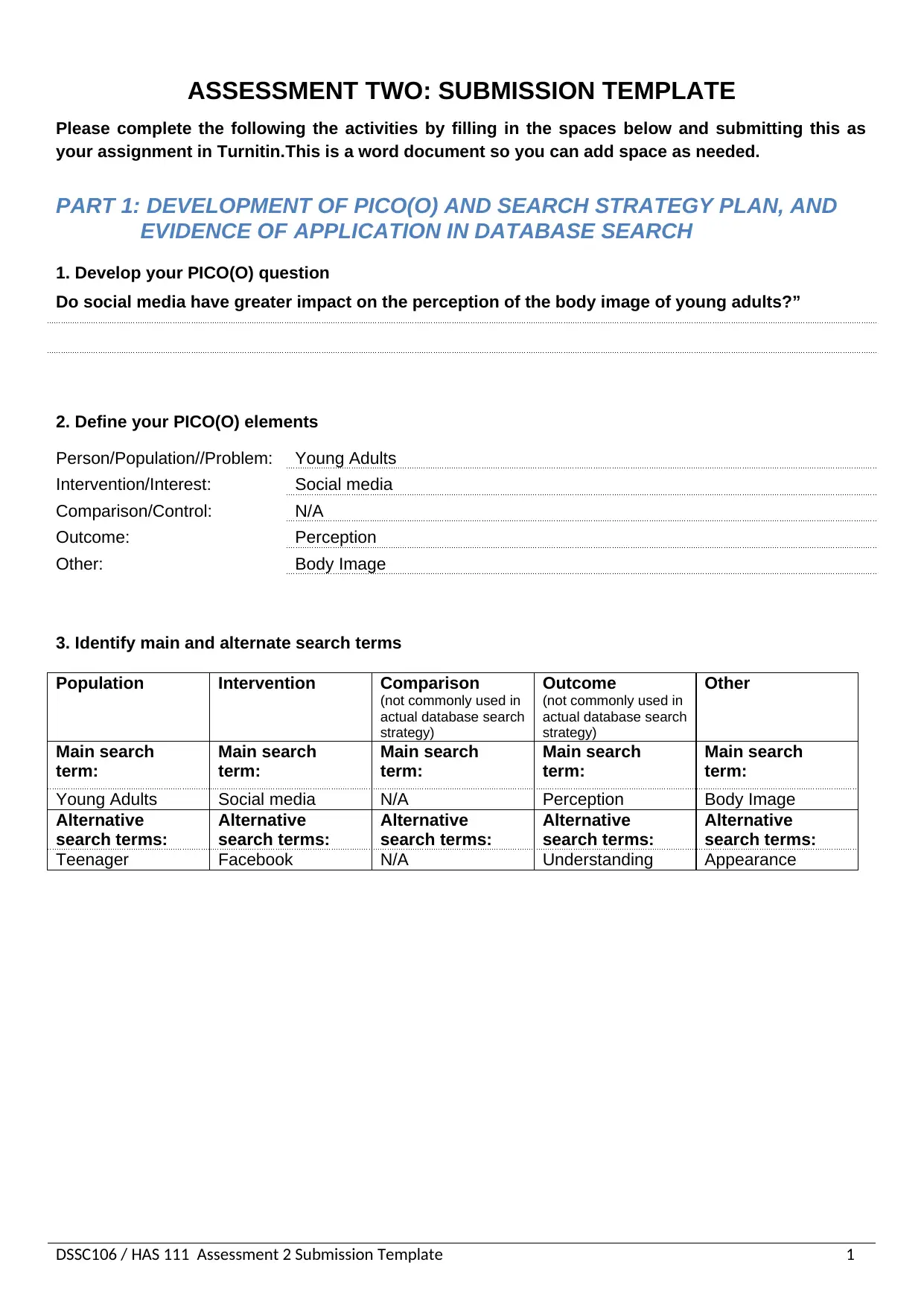
ASSESSMENT TWO: SUBMISSION TEMPLATE
Please complete the following the activities by filling in the spaces below and submitting this as
your assignment in Turnitin.This is a word document so you can add space as needed.
PART 1: DEVELOPMENT OF PICO(O) AND SEARCH STRATEGY PLAN, AND
EVIDENCE OF APPLICATION IN DATABASE SEARCH
1. Develop your PICO(O) question
Do social media have greater impact on the perception of the body image of young adults?”
2. Define your PICO(O) elements
Person/Population//Problem: Young Adults
Intervention/Interest: Social media
Comparison/Control: N/A
Outcome: Perception
Other: Body Image
3. Identify main and alternate search terms
Population Intervention Comparison
(not commonly used in
actual database search
strategy)
Outcome
(not commonly used in
actual database search
strategy)
Other
Main search
term:
Main search
term:
Main search
term:
Main search
term:
Main search
term:
Young Adults Social media N/A Perception Body Image
Alternative
search terms:
Alternative
search terms:
Alternative
search terms:
Alternative
search terms:
Alternative
search terms:
Teenager Facebook N/A Understanding Appearance
DSSC106 / HAS 111 Assessment 2 Submission Template 1
Please complete the following the activities by filling in the spaces below and submitting this as
your assignment in Turnitin.This is a word document so you can add space as needed.
PART 1: DEVELOPMENT OF PICO(O) AND SEARCH STRATEGY PLAN, AND
EVIDENCE OF APPLICATION IN DATABASE SEARCH
1. Develop your PICO(O) question
Do social media have greater impact on the perception of the body image of young adults?”
2. Define your PICO(O) elements
Person/Population//Problem: Young Adults
Intervention/Interest: Social media
Comparison/Control: N/A
Outcome: Perception
Other: Body Image
3. Identify main and alternate search terms
Population Intervention Comparison
(not commonly used in
actual database search
strategy)
Outcome
(not commonly used in
actual database search
strategy)
Other
Main search
term:
Main search
term:
Main search
term:
Main search
term:
Main search
term:
Young Adults Social media N/A Perception Body Image
Alternative
search terms:
Alternative
search terms:
Alternative
search terms:
Alternative
search terms:
Alternative
search terms:
Teenager Facebook N/A Understanding Appearance
DSSC106 / HAS 111 Assessment 2 Submission Template 1
Paraphrase This Document
Need a fresh take? Get an instant paraphrase of this document with our AI Paraphraser

4. Place the screenshot/screengrab/digital picture of your database searchhere. Please ensure your
screenshot provide all steps of your search and are clear enough to be legible – these must be
READABLE!Note: the number of search items found for each line of your search must be shown;
rerun the search if needed.Use the crop function to crop out unnecessary information so that you
can enlarge your screenshot.Your name on your library folder must be readable.
DSSC106 / HAS 111 Assessment 2 Submission Template 2
screenshot provide all steps of your search and are clear enough to be legible – these must be
READABLE!Note: the number of search items found for each line of your search must be shown;
rerun the search if needed.Use the crop function to crop out unnecessary information so that you
can enlarge your screenshot.Your name on your library folder must be readable.
DSSC106 / HAS 111 Assessment 2 Submission Template 2

5. Identify limits if any
6. Place the screenshot at least four papers from your search that you have used in your essay
(seee.g. below).
DSSC106 / HAS 111 Assessment 2 Submission Template 3
6. Place the screenshot at least four papers from your search that you have used in your essay
(seee.g. below).
DSSC106 / HAS 111 Assessment 2 Submission Template 3
⊘ This is a preview!⊘
Do you want full access?
Subscribe today to unlock all pages.

Trusted by 1+ million students worldwide
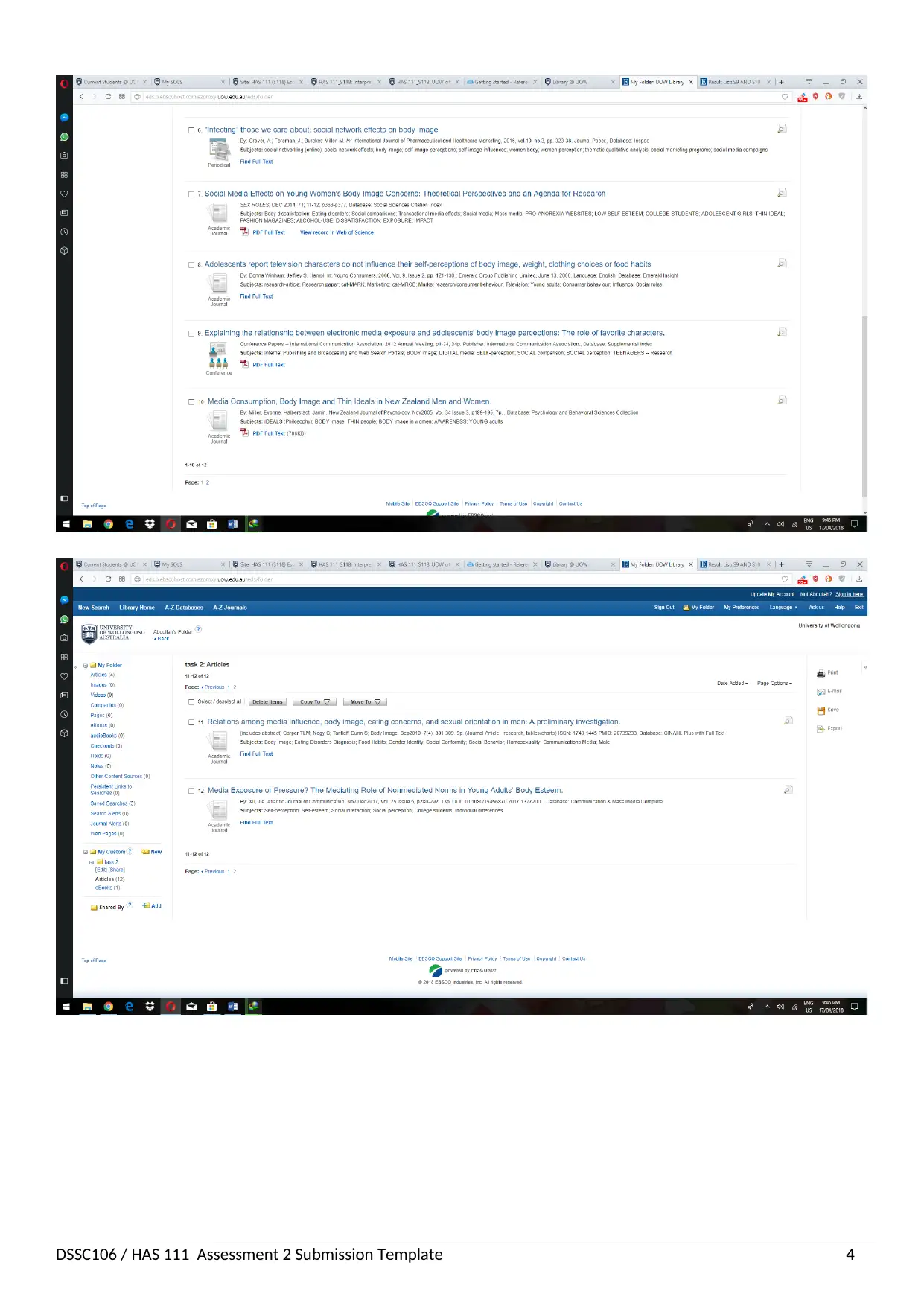
DSSC106 / HAS 111 Assessment 2 Submission Template 4
Paraphrase This Document
Need a fresh take? Get an instant paraphrase of this document with our AI Paraphraser

7. Essay.
The past few decades have been witnessing social media as a well-evaluated
investigated area in relation to the effect and impact on body image, anxiety along with self-
esteem in young adults (Thompson and Lougheed 2012). The social media has been playing a
consequential and outsized role in the process of communication of cultural stereotypes in relation
to the aesthetics of body image. Social media has been reflecting both positive and negative
impact on individuals’ self-esteem often relying on the nature of the comments posted on social
media platform (Eyal and Te'eni-Harari 2013). The social media particularly has been increasingly
developing as a domain that underlines cultural and intellectual beliefs and perceives strong views
on the way a person looks, that individuals repeatedly have been assessing and perpetuating. The
thesis statement of this paper is “Social media has greater impact on the perception of the body
image of young adults and teenagers”. The significance of the essay is to highlight the evaluating
effects on social networking sites like Facebook on the people belonging to the young adult
generation.
DSSC106 / HAS 111 Assessment 2 Submission Template 5
The past few decades have been witnessing social media as a well-evaluated
investigated area in relation to the effect and impact on body image, anxiety along with self-
esteem in young adults (Thompson and Lougheed 2012). The social media has been playing a
consequential and outsized role in the process of communication of cultural stereotypes in relation
to the aesthetics of body image. Social media has been reflecting both positive and negative
impact on individuals’ self-esteem often relying on the nature of the comments posted on social
media platform (Eyal and Te'eni-Harari 2013). The social media particularly has been increasingly
developing as a domain that underlines cultural and intellectual beliefs and perceives strong views
on the way a person looks, that individuals repeatedly have been assessing and perpetuating. The
thesis statement of this paper is “Social media has greater impact on the perception of the body
image of young adults and teenagers”. The significance of the essay is to highlight the evaluating
effects on social networking sites like Facebook on the people belonging to the young adult
generation.
DSSC106 / HAS 111 Assessment 2 Submission Template 5
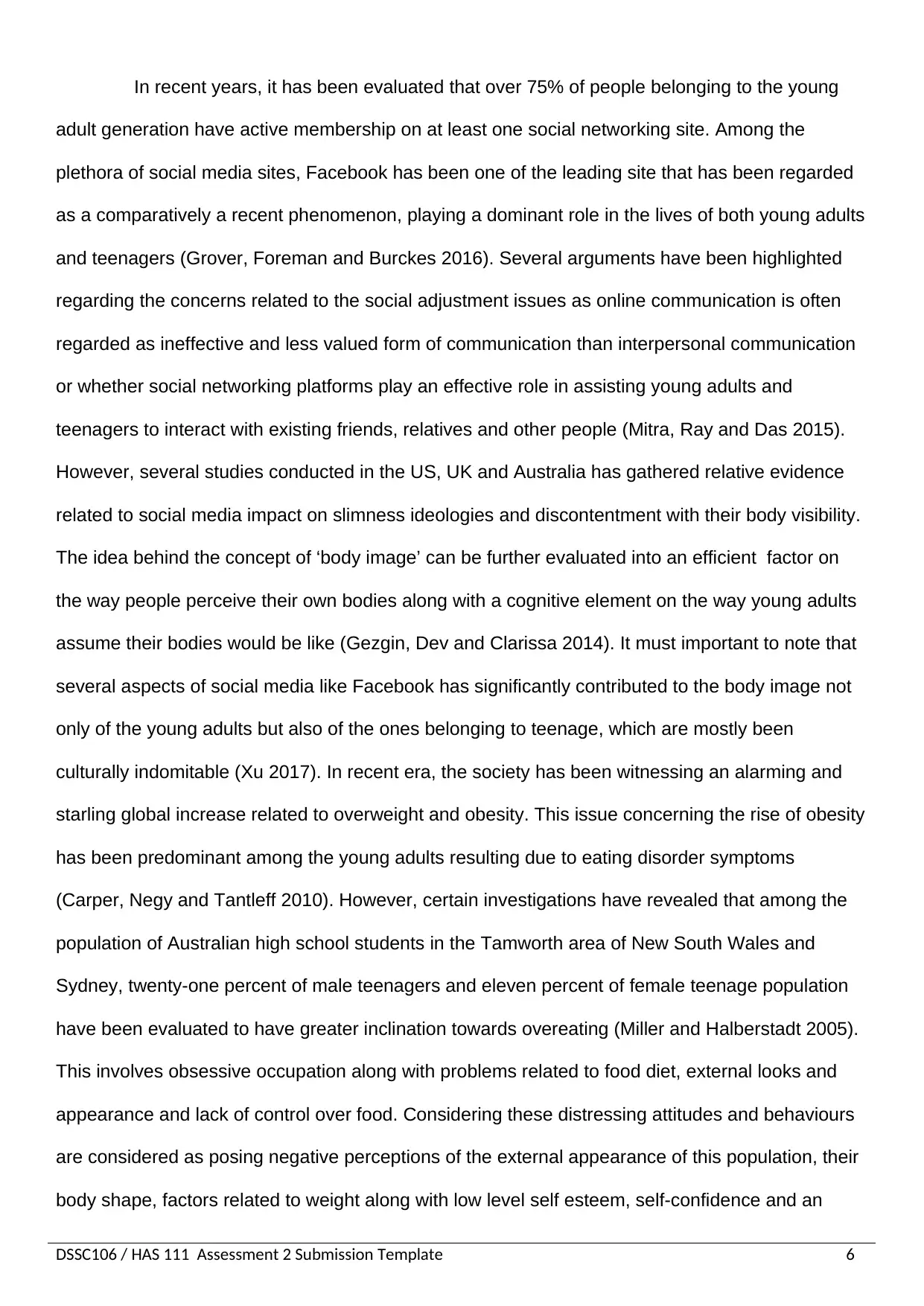
In recent years, it has been evaluated that over 75% of people belonging to the young
adult generation have active membership on at least one social networking site. Among the
plethora of social media sites, Facebook has been one of the leading site that has been regarded
as a comparatively a recent phenomenon, playing a dominant role in the lives of both young adults
and teenagers (Grover, Foreman and Burckes 2016). Several arguments have been highlighted
regarding the concerns related to the social adjustment issues as online communication is often
regarded as ineffective and less valued form of communication than interpersonal communication
or whether social networking platforms play an effective role in assisting young adults and
teenagers to interact with existing friends, relatives and other people (Mitra, Ray and Das 2015).
However, several studies conducted in the US, UK and Australia has gathered relative evidence
related to social media impact on slimness ideologies and discontentment with their body visibility.
The idea behind the concept of ‘body image’ can be further evaluated into an efficient factor on
the way people perceive their own bodies along with a cognitive element on the way young adults
assume their bodies would be like (Gezgin, Dev and Clarissa 2014). It must important to note that
several aspects of social media like Facebook has significantly contributed to the body image not
only of the young adults but also of the ones belonging to teenage, which are mostly been
culturally indomitable (Xu 2017). In recent era, the society has been witnessing an alarming and
starling global increase related to overweight and obesity. This issue concerning the rise of obesity
has been predominant among the young adults resulting due to eating disorder symptoms
(Carper, Negy and Tantleff 2010). However, certain investigations have revealed that among the
population of Australian high school students in the Tamworth area of New South Wales and
Sydney, twenty-one percent of male teenagers and eleven percent of female teenage population
have been evaluated to have greater inclination towards overeating (Miller and Halberstadt 2005).
This involves obsessive occupation along with problems related to food diet, external looks and
appearance and lack of control over food. Considering these distressing attitudes and behaviours
are considered as posing negative perceptions of the external appearance of this population, their
body shape, factors related to weight along with low level self esteem, self-confidence and an
DSSC106 / HAS 111 Assessment 2 Submission Template 6
adult generation have active membership on at least one social networking site. Among the
plethora of social media sites, Facebook has been one of the leading site that has been regarded
as a comparatively a recent phenomenon, playing a dominant role in the lives of both young adults
and teenagers (Grover, Foreman and Burckes 2016). Several arguments have been highlighted
regarding the concerns related to the social adjustment issues as online communication is often
regarded as ineffective and less valued form of communication than interpersonal communication
or whether social networking platforms play an effective role in assisting young adults and
teenagers to interact with existing friends, relatives and other people (Mitra, Ray and Das 2015).
However, several studies conducted in the US, UK and Australia has gathered relative evidence
related to social media impact on slimness ideologies and discontentment with their body visibility.
The idea behind the concept of ‘body image’ can be further evaluated into an efficient factor on
the way people perceive their own bodies along with a cognitive element on the way young adults
assume their bodies would be like (Gezgin, Dev and Clarissa 2014). It must important to note that
several aspects of social media like Facebook has significantly contributed to the body image not
only of the young adults but also of the ones belonging to teenage, which are mostly been
culturally indomitable (Xu 2017). In recent era, the society has been witnessing an alarming and
starling global increase related to overweight and obesity. This issue concerning the rise of obesity
has been predominant among the young adults resulting due to eating disorder symptoms
(Carper, Negy and Tantleff 2010). However, certain investigations have revealed that among the
population of Australian high school students in the Tamworth area of New South Wales and
Sydney, twenty-one percent of male teenagers and eleven percent of female teenage population
have been evaluated to have greater inclination towards overeating (Miller and Halberstadt 2005).
This involves obsessive occupation along with problems related to food diet, external looks and
appearance and lack of control over food. Considering these distressing attitudes and behaviours
are considered as posing negative perceptions of the external appearance of this population, their
body shape, factors related to weight along with low level self esteem, self-confidence and an
DSSC106 / HAS 111 Assessment 2 Submission Template 6
⊘ This is a preview!⊘
Do you want full access?
Subscribe today to unlock all pages.

Trusted by 1+ million students worldwide
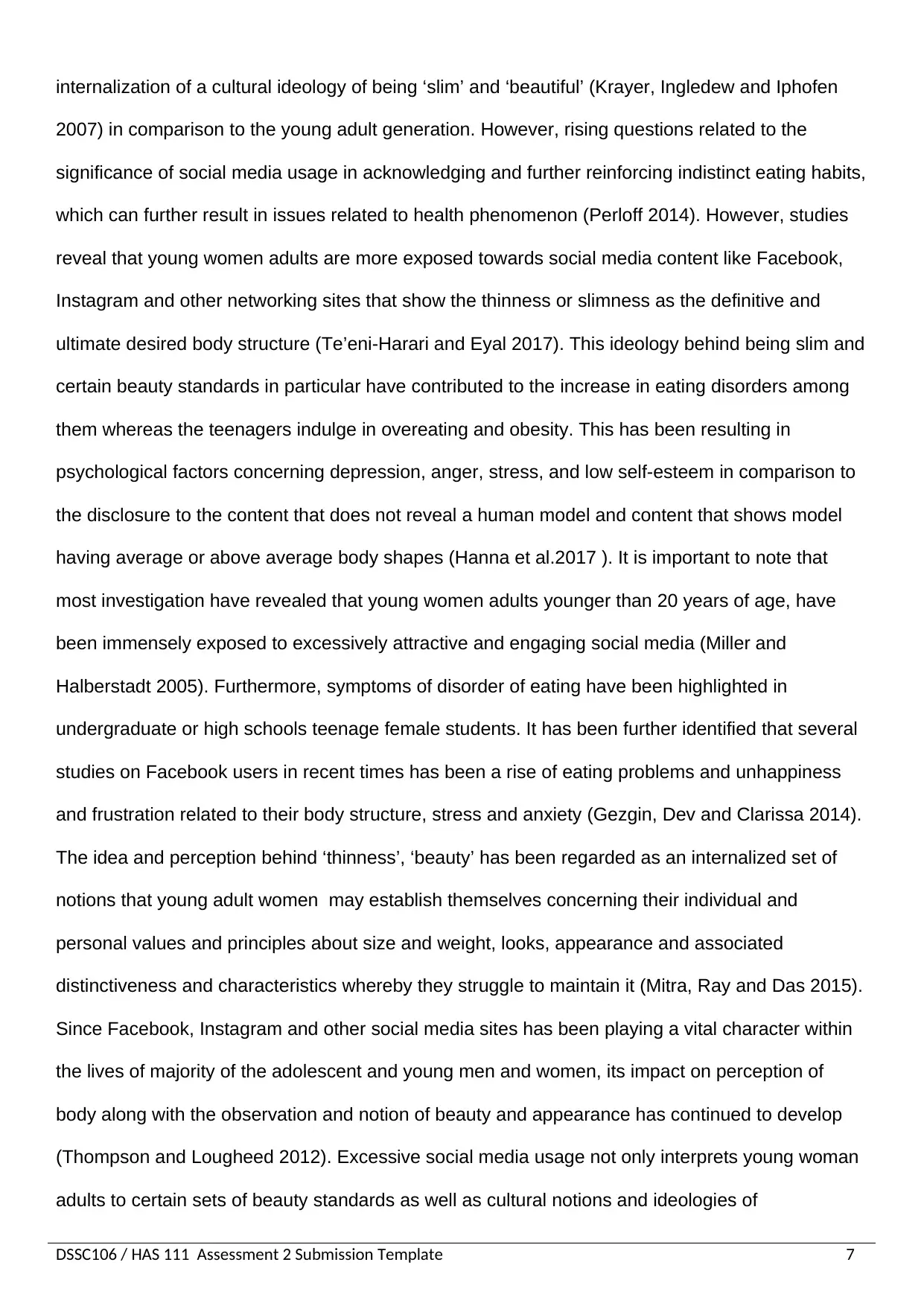
internalization of a cultural ideology of being ‘slim’ and ‘beautiful’ (Krayer, Ingledew and Iphofen
2007) in comparison to the young adult generation. However, rising questions related to the
significance of social media usage in acknowledging and further reinforcing indistinct eating habits,
which can further result in issues related to health phenomenon (Perloff 2014). However, studies
reveal that young women adults are more exposed towards social media content like Facebook,
Instagram and other networking sites that show the thinness or slimness as the definitive and
ultimate desired body structure (Te’eni-Harari and Eyal 2017). This ideology behind being slim and
certain beauty standards in particular have contributed to the increase in eating disorders among
them whereas the teenagers indulge in overeating and obesity. This has been resulting in
psychological factors concerning depression, anger, stress, and low self-esteem in comparison to
the disclosure to the content that does not reveal a human model and content that shows model
having average or above average body shapes (Hanna et al.2017 ). It is important to note that
most investigation have revealed that young women adults younger than 20 years of age, have
been immensely exposed to excessively attractive and engaging social media (Miller and
Halberstadt 2005). Furthermore, symptoms of disorder of eating have been highlighted in
undergraduate or high schools teenage female students. It has been further identified that several
studies on Facebook users in recent times has been a rise of eating problems and unhappiness
and frustration related to their body structure, stress and anxiety (Gezgin, Dev and Clarissa 2014).
The idea and perception behind ‘thinness’, ‘beauty’ has been regarded as an internalized set of
notions that young adult women may establish themselves concerning their individual and
personal values and principles about size and weight, looks, appearance and associated
distinctiveness and characteristics whereby they struggle to maintain it (Mitra, Ray and Das 2015).
Since Facebook, Instagram and other social media sites has been playing a vital character within
the lives of majority of the adolescent and young men and women, its impact on perception of
body along with the observation and notion of beauty and appearance has continued to develop
(Thompson and Lougheed 2012). Excessive social media usage not only interprets young woman
adults to certain sets of beauty standards as well as cultural notions and ideologies of
DSSC106 / HAS 111 Assessment 2 Submission Template 7
2007) in comparison to the young adult generation. However, rising questions related to the
significance of social media usage in acknowledging and further reinforcing indistinct eating habits,
which can further result in issues related to health phenomenon (Perloff 2014). However, studies
reveal that young women adults are more exposed towards social media content like Facebook,
Instagram and other networking sites that show the thinness or slimness as the definitive and
ultimate desired body structure (Te’eni-Harari and Eyal 2017). This ideology behind being slim and
certain beauty standards in particular have contributed to the increase in eating disorders among
them whereas the teenagers indulge in overeating and obesity. This has been resulting in
psychological factors concerning depression, anger, stress, and low self-esteem in comparison to
the disclosure to the content that does not reveal a human model and content that shows model
having average or above average body shapes (Hanna et al.2017 ). It is important to note that
most investigation have revealed that young women adults younger than 20 years of age, have
been immensely exposed to excessively attractive and engaging social media (Miller and
Halberstadt 2005). Furthermore, symptoms of disorder of eating have been highlighted in
undergraduate or high schools teenage female students. It has been further identified that several
studies on Facebook users in recent times has been a rise of eating problems and unhappiness
and frustration related to their body structure, stress and anxiety (Gezgin, Dev and Clarissa 2014).
The idea and perception behind ‘thinness’, ‘beauty’ has been regarded as an internalized set of
notions that young adult women may establish themselves concerning their individual and
personal values and principles about size and weight, looks, appearance and associated
distinctiveness and characteristics whereby they struggle to maintain it (Mitra, Ray and Das 2015).
Since Facebook, Instagram and other social media sites has been playing a vital character within
the lives of majority of the adolescent and young men and women, its impact on perception of
body along with the observation and notion of beauty and appearance has continued to develop
(Thompson and Lougheed 2012). Excessive social media usage not only interprets young woman
adults to certain sets of beauty standards as well as cultural notions and ideologies of
DSSC106 / HAS 111 Assessment 2 Submission Template 7
Paraphrase This Document
Need a fresh take? Get an instant paraphrase of this document with our AI Paraphraser

womanhood. It must be taken into consideration that despite of increasing knowledge and
awareness of this situation, the role of Facebook in rising aspects of discontentment, body
dysmorphia along with eating habits has not altered among this generation (Perloff 2014).
Facebook, being the only networking site with an average of 900 million people scrolling through
their news update, among them almost 50% of the viewers belong to the young adult generation.
The body image unhappiness has been revealed to cause by Facebook that has taken into
account while interacting to individuals about their unhappiness and frustration related to body
image (Te’eni-Harari and Eyal 2017). It must be highlighted that in spite of actual body weight,
majority of young women adults belonging to western cultures are immensely concerned about
loss of body weight and promoting thinness. However, it must be noted that excessive usage of
Facebook has resulted teenagers to indulge in developing ideas related to body shaming and
bullying. Recent investigation evaluated social comparison that is considered as a personality and
characteristics variable that further anticipate the negative and damaging effects of Facebook
exposure in body image (Te’eni-Harari and Eyal 2017). It has been evaluated that young female
adults who face severe dissatisfaction to body image as an outcome of unfavourable body
judgment that raises frustration among this young generation further destructing and hampering
their future competences. Free and unlimited accessibility to create a personal profile on a social
networking site have caused immense exposure to negative and distressing media standards
through social media platform (Hanna et al.2017 ). The major section of young college learners
especially women have been extensively vulnerable towards Facebook and thus have been
experiencing repeated coverage to negative and depressing body sensitivity like thin ideology and
self comparison or assessment to renowned personalities (Perloff 2014). They further provide the
opportunity of consumers to present themselves based on their preferences on their personal
Facebook profiles, which could contribute to a degraded sense of self-esteem and perception of
body image.
However, social cognitive theory of body image has facilitated the usage of
comprehensive theoretical approach in order to shed light on the interaction between
DSSC106 / HAS 111 Assessment 2 Submission Template 8
awareness of this situation, the role of Facebook in rising aspects of discontentment, body
dysmorphia along with eating habits has not altered among this generation (Perloff 2014).
Facebook, being the only networking site with an average of 900 million people scrolling through
their news update, among them almost 50% of the viewers belong to the young adult generation.
The body image unhappiness has been revealed to cause by Facebook that has taken into
account while interacting to individuals about their unhappiness and frustration related to body
image (Te’eni-Harari and Eyal 2017). It must be highlighted that in spite of actual body weight,
majority of young women adults belonging to western cultures are immensely concerned about
loss of body weight and promoting thinness. However, it must be noted that excessive usage of
Facebook has resulted teenagers to indulge in developing ideas related to body shaming and
bullying. Recent investigation evaluated social comparison that is considered as a personality and
characteristics variable that further anticipate the negative and damaging effects of Facebook
exposure in body image (Te’eni-Harari and Eyal 2017). It has been evaluated that young female
adults who face severe dissatisfaction to body image as an outcome of unfavourable body
judgment that raises frustration among this young generation further destructing and hampering
their future competences. Free and unlimited accessibility to create a personal profile on a social
networking site have caused immense exposure to negative and distressing media standards
through social media platform (Hanna et al.2017 ). The major section of young college learners
especially women have been extensively vulnerable towards Facebook and thus have been
experiencing repeated coverage to negative and depressing body sensitivity like thin ideology and
self comparison or assessment to renowned personalities (Perloff 2014). They further provide the
opportunity of consumers to present themselves based on their preferences on their personal
Facebook profiles, which could contribute to a degraded sense of self-esteem and perception of
body image.
However, social cognitive theory of body image has facilitated the usage of
comprehensive theoretical approach in order to shed light on the interaction between
DSSC106 / HAS 111 Assessment 2 Submission Template 8
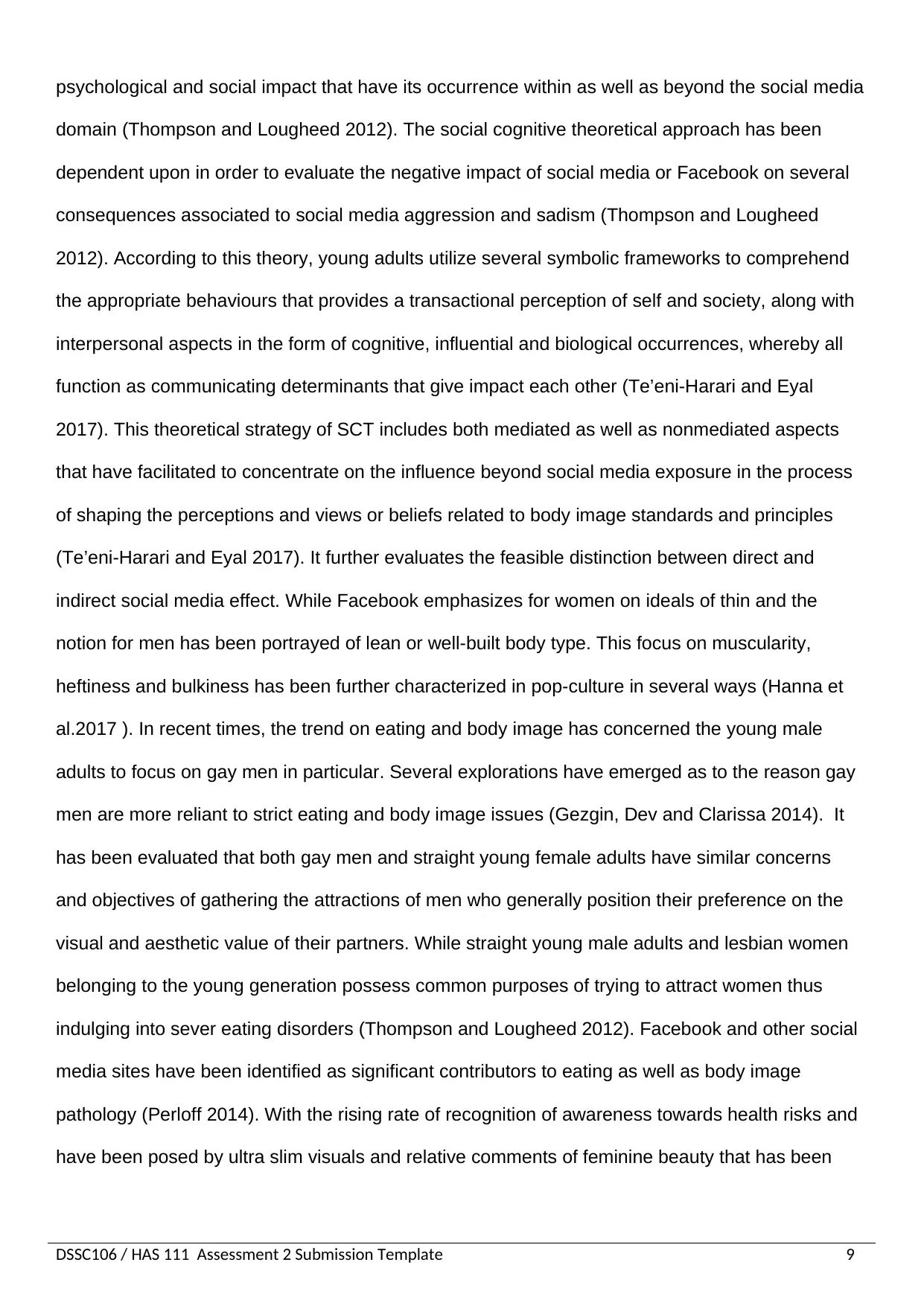
psychological and social impact that have its occurrence within as well as beyond the social media
domain (Thompson and Lougheed 2012). The social cognitive theoretical approach has been
dependent upon in order to evaluate the negative impact of social media or Facebook on several
consequences associated to social media aggression and sadism (Thompson and Lougheed
2012). According to this theory, young adults utilize several symbolic frameworks to comprehend
the appropriate behaviours that provides a transactional perception of self and society, along with
interpersonal aspects in the form of cognitive, influential and biological occurrences, whereby all
function as communicating determinants that give impact each other (Te’eni-Harari and Eyal
2017). This theoretical strategy of SCT includes both mediated as well as nonmediated aspects
that have facilitated to concentrate on the influence beyond social media exposure in the process
of shaping the perceptions and views or beliefs related to body image standards and principles
(Te’eni-Harari and Eyal 2017). It further evaluates the feasible distinction between direct and
indirect social media effect. While Facebook emphasizes for women on ideals of thin and the
notion for men has been portrayed of lean or well-built body type. This focus on muscularity,
heftiness and bulkiness has been further characterized in pop-culture in several ways (Hanna et
al.2017 ). In recent times, the trend on eating and body image has concerned the young male
adults to focus on gay men in particular. Several explorations have emerged as to the reason gay
men are more reliant to strict eating and body image issues (Gezgin, Dev and Clarissa 2014). It
has been evaluated that both gay men and straight young female adults have similar concerns
and objectives of gathering the attractions of men who generally position their preference on the
visual and aesthetic value of their partners. While straight young male adults and lesbian women
belonging to the young generation possess common purposes of trying to attract women thus
indulging into sever eating disorders (Thompson and Lougheed 2012). Facebook and other social
media sites have been identified as significant contributors to eating as well as body image
pathology (Perloff 2014). With the rising rate of recognition of awareness towards health risks and
have been posed by ultra slim visuals and relative comments of feminine beauty that has been
DSSC106 / HAS 111 Assessment 2 Submission Template 9
domain (Thompson and Lougheed 2012). The social cognitive theoretical approach has been
dependent upon in order to evaluate the negative impact of social media or Facebook on several
consequences associated to social media aggression and sadism (Thompson and Lougheed
2012). According to this theory, young adults utilize several symbolic frameworks to comprehend
the appropriate behaviours that provides a transactional perception of self and society, along with
interpersonal aspects in the form of cognitive, influential and biological occurrences, whereby all
function as communicating determinants that give impact each other (Te’eni-Harari and Eyal
2017). This theoretical strategy of SCT includes both mediated as well as nonmediated aspects
that have facilitated to concentrate on the influence beyond social media exposure in the process
of shaping the perceptions and views or beliefs related to body image standards and principles
(Te’eni-Harari and Eyal 2017). It further evaluates the feasible distinction between direct and
indirect social media effect. While Facebook emphasizes for women on ideals of thin and the
notion for men has been portrayed of lean or well-built body type. This focus on muscularity,
heftiness and bulkiness has been further characterized in pop-culture in several ways (Hanna et
al.2017 ). In recent times, the trend on eating and body image has concerned the young male
adults to focus on gay men in particular. Several explorations have emerged as to the reason gay
men are more reliant to strict eating and body image issues (Gezgin, Dev and Clarissa 2014). It
has been evaluated that both gay men and straight young female adults have similar concerns
and objectives of gathering the attractions of men who generally position their preference on the
visual and aesthetic value of their partners. While straight young male adults and lesbian women
belonging to the young generation possess common purposes of trying to attract women thus
indulging into sever eating disorders (Thompson and Lougheed 2012). Facebook and other social
media sites have been identified as significant contributors to eating as well as body image
pathology (Perloff 2014). With the rising rate of recognition of awareness towards health risks and
have been posed by ultra slim visuals and relative comments of feminine beauty that has been
DSSC106 / HAS 111 Assessment 2 Submission Template 9
⊘ This is a preview!⊘
Do you want full access?
Subscribe today to unlock all pages.

Trusted by 1+ million students worldwide

causing detrimental effects on both young male and female adults (Thompson and Lougheed
2012).
Thus, it can be seen that relevant exposures and explanations have successfully been
enlightened through the aforementioned PICO question related to the impact of social media
usage on the perception of body image. While Facebook usage has resulted teenagers to develop
ideas related to body shaming, on the other hand both male and female young adults within the
age of 35 being influenced by excessive social media usage thereby giving rise to the notions
related to thinness and body dissatisfaction.
DSSC106 / HAS 111 Assessment 2 Submission Template 10
2012).
Thus, it can be seen that relevant exposures and explanations have successfully been
enlightened through the aforementioned PICO question related to the impact of social media
usage on the perception of body image. While Facebook usage has resulted teenagers to develop
ideas related to body shaming, on the other hand both male and female young adults within the
age of 35 being influenced by excessive social media usage thereby giving rise to the notions
related to thinness and body dissatisfaction.
DSSC106 / HAS 111 Assessment 2 Submission Template 10
Paraphrase This Document
Need a fresh take? Get an instant paraphrase of this document with our AI Paraphraser

References
Carper, T.L.M., Negy, C. and Tantleff-Dunn, S., 2010. Relations among media influence, body
image, eating concerns, and sexual orientation in men: A preliminary investigation. Body
Image, 7(4), pp.301-309.
Eyal, K. and Te'eni-Harari, T., 2013. Explaining the relationship between media exposure and
early adolescents’ body image perceptions: The role of favorite characters. Journal of
Media Psychology: Theories, Methods, and Applications, 25(3), p.129.
Gezgin, U.B., Dev, A. and Clarissa, V., 2014. Of Kate Moss & Marilyn Monroe: Body
Dissatisfaction and its Relation to Media Consumption, Body Mass Index and Self-Esteem
in Malaysian College Women. Akdeniz Iletisim, (22).
Grover, A., Foreman, J. and Burckes-Miller, M., 2016. “Infecting” those we care about: social
network effects on body image. International Journal of Pharmaceutical and Healthcare
Marketing, 10(3), pp.323-338.
Hanna, E., Ward, L.M., Seabrook, R.C., Jerald, M., Reed, L., Giaccardi, S. and Lippman, J.R.,
2017. Contributions of social comparison and self-objectification in mediating associations
between facebook use and emergent adults' psychological well-being. Cyberpsychology,
Behavior, and Social Networking, 20(3), pp.172-179.
Krayer, A., Ingledew, D.K. and Iphofen, R., 2007. Social comparison and body image in
adolescence: a grounded theory approach. Health Education Research, 23(5), pp.892-903.
Miller, E. and Halberstadt, J., 2005. Media consumption, body image and thin ideals in New
Zealand men and women. New Zealand Journal of Psychology, 34(3), pp.189-195.
Mitra, S.A., Ray, D. and Das, S., 2015. Influence of media on body image satisfaction an
exploratory study on urban Bengali females. Indian Journal of Health and Wellbeing, 6(11),
p.1100.
DSSC106 / HAS 111 Assessment 2 Submission Template 11
Carper, T.L.M., Negy, C. and Tantleff-Dunn, S., 2010. Relations among media influence, body
image, eating concerns, and sexual orientation in men: A preliminary investigation. Body
Image, 7(4), pp.301-309.
Eyal, K. and Te'eni-Harari, T., 2013. Explaining the relationship between media exposure and
early adolescents’ body image perceptions: The role of favorite characters. Journal of
Media Psychology: Theories, Methods, and Applications, 25(3), p.129.
Gezgin, U.B., Dev, A. and Clarissa, V., 2014. Of Kate Moss & Marilyn Monroe: Body
Dissatisfaction and its Relation to Media Consumption, Body Mass Index and Self-Esteem
in Malaysian College Women. Akdeniz Iletisim, (22).
Grover, A., Foreman, J. and Burckes-Miller, M., 2016. “Infecting” those we care about: social
network effects on body image. International Journal of Pharmaceutical and Healthcare
Marketing, 10(3), pp.323-338.
Hanna, E., Ward, L.M., Seabrook, R.C., Jerald, M., Reed, L., Giaccardi, S. and Lippman, J.R.,
2017. Contributions of social comparison and self-objectification in mediating associations
between facebook use and emergent adults' psychological well-being. Cyberpsychology,
Behavior, and Social Networking, 20(3), pp.172-179.
Krayer, A., Ingledew, D.K. and Iphofen, R., 2007. Social comparison and body image in
adolescence: a grounded theory approach. Health Education Research, 23(5), pp.892-903.
Miller, E. and Halberstadt, J., 2005. Media consumption, body image and thin ideals in New
Zealand men and women. New Zealand Journal of Psychology, 34(3), pp.189-195.
Mitra, S.A., Ray, D. and Das, S., 2015. Influence of media on body image satisfaction an
exploratory study on urban Bengali females. Indian Journal of Health and Wellbeing, 6(11),
p.1100.
DSSC106 / HAS 111 Assessment 2 Submission Template 11
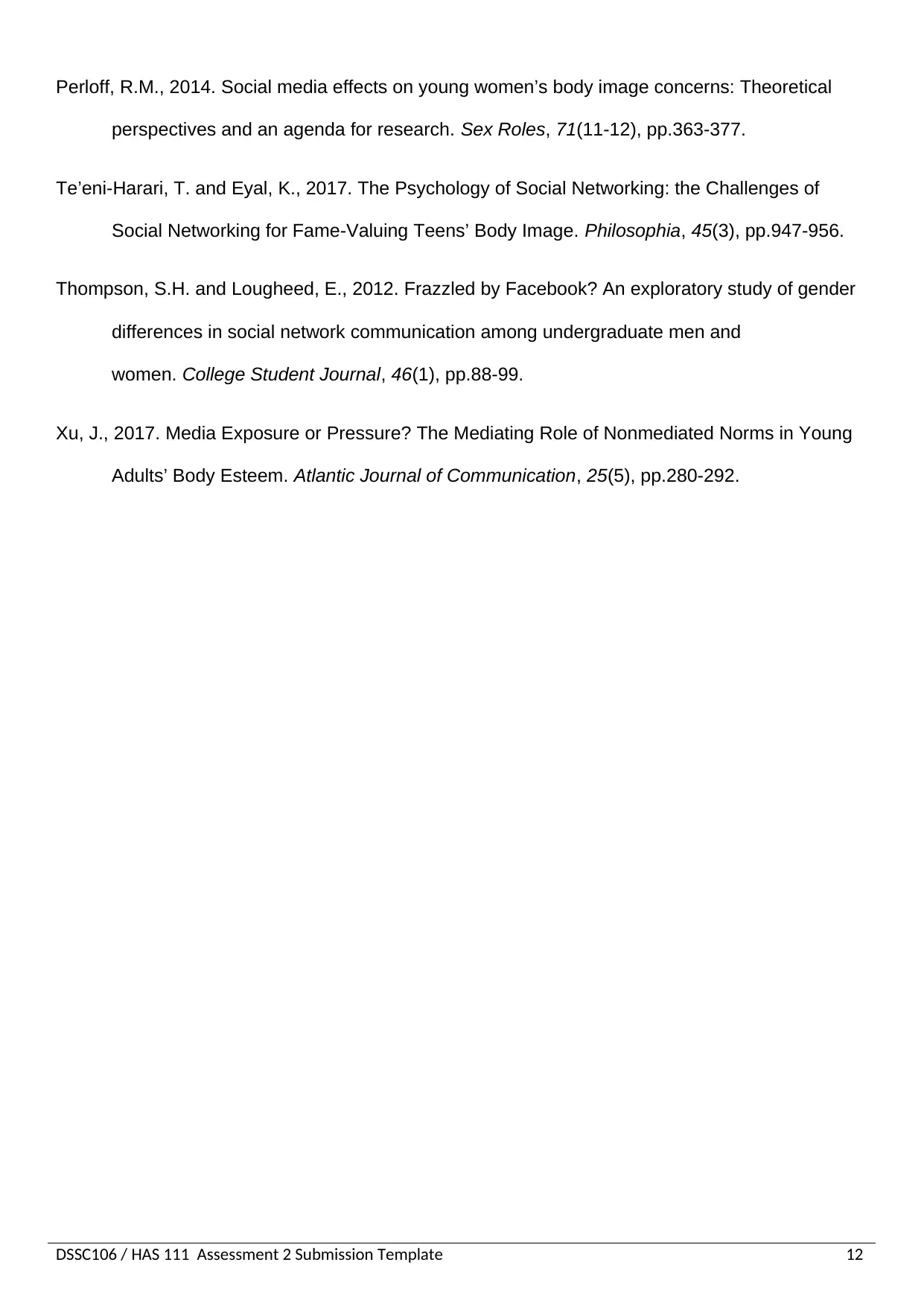
Perloff, R.M., 2014. Social media effects on young women’s body image concerns: Theoretical
perspectives and an agenda for research. Sex Roles, 71(11-12), pp.363-377.
Te’eni-Harari, T. and Eyal, K., 2017. The Psychology of Social Networking: the Challenges of
Social Networking for Fame-Valuing Teens’ Body Image. Philosophia, 45(3), pp.947-956.
Thompson, S.H. and Lougheed, E., 2012. Frazzled by Facebook? An exploratory study of gender
differences in social network communication among undergraduate men and
women. College Student Journal, 46(1), pp.88-99.
Xu, J., 2017. Media Exposure or Pressure? The Mediating Role of Nonmediated Norms in Young
Adults’ Body Esteem. Atlantic Journal of Communication, 25(5), pp.280-292.
DSSC106 / HAS 111 Assessment 2 Submission Template 12
perspectives and an agenda for research. Sex Roles, 71(11-12), pp.363-377.
Te’eni-Harari, T. and Eyal, K., 2017. The Psychology of Social Networking: the Challenges of
Social Networking for Fame-Valuing Teens’ Body Image. Philosophia, 45(3), pp.947-956.
Thompson, S.H. and Lougheed, E., 2012. Frazzled by Facebook? An exploratory study of gender
differences in social network communication among undergraduate men and
women. College Student Journal, 46(1), pp.88-99.
Xu, J., 2017. Media Exposure or Pressure? The Mediating Role of Nonmediated Norms in Young
Adults’ Body Esteem. Atlantic Journal of Communication, 25(5), pp.280-292.
DSSC106 / HAS 111 Assessment 2 Submission Template 12
⊘ This is a preview!⊘
Do you want full access?
Subscribe today to unlock all pages.

Trusted by 1+ million students worldwide
1 out of 12
Related Documents
Your All-in-One AI-Powered Toolkit for Academic Success.
+13062052269
info@desklib.com
Available 24*7 on WhatsApp / Email
![[object Object]](/_next/static/media/star-bottom.7253800d.svg)
Unlock your academic potential
Copyright © 2020–2025 A2Z Services. All Rights Reserved. Developed and managed by ZUCOL.




